10 Emotion and Motivation

CHAPTER OUTLINE
10.1 Motivation
10.2 Hunger and Eating
10.3 Sexual Behavior
10.4 Emotion
In this chapter, we will explore issues relating to both motivation and emotion. We will begin with a discussion of several theories that have been proposed to explain motivation and why we engage in a given behavior. You will learn about the physiological needs that drive some human behaviors, as well as the importance of our social experiences in influencing our actions.
Next, we will consider both eating and having sex as examples of motivated behaviors. What are the physiological mechanisms of hunger and satiety? What understanding do scientists have of why obesity occurs, and what treatments exist for obesity and eating disorders? How has research into human sex and sexuality evolved over the past century? How do psychologists understand and study the human experience of sexual orientation and gender identity? These questions—and more—will be explored.
This chapter will close with a discussion of emotion. You will learn about several theories that have been proposed to explain how emotion occurs, the biological underpinnings of emotion, and the universality of emotions.
10.1 Motivation
LEARNING OBJECTIVES
By the end of this section, you will be able to:
- Define intrinsic and extrinsic motivation
- Understand that instincts, drive reduction, self-efficacy, and social motives have all been proposed as theories of motivation
- Explain the basic concepts associated with Maslow’s hierarchy of needs
Why do we do the things we do? What motivations underlie our behaviors? Motivation describes the wants or needs that direct behavior toward a goal. In addition to biological motives, motivations can be intrinsic (arising from internal factors) or extrinsic (arising from external factors) (Figure 10.2). Intrinsically motivated behaviors are performed because of the sense of personal satisfaction that they bring, while extrinsically motivated behaviors are performed in order to receive something from others.

In reality, our motivations are often a mix of both intrinsic and extrinsic factors, but the nature of the mix of these factors might change over time (often in ways that seem counter-intuitive). There is an old adage: “Choose a job that you love, and you will never have to work a day in your life,” meaning that if you enjoy your occupation, work doesn’t seem like . . . well, work. Some research suggests that this isn’t necessarily the case (Daniel & Esser, 1980; Deci, 1972; Deci, Koestner, & Ryan, 1999). According to this research, receiving some sort of extrinsic reinforcement (i.e., getting paid) for engaging in behaviors that we enjoy leads to those behaviors being thought of as work no longer providing that same enjoyment. As a result, we might spend less time engaging in these reclassified behaviors in the absence of any extrinsic reinforcement. For example, Odessa loves baking, so in her free time, she bakes for fun. Oftentimes, after stocking shelves at her grocery store job, she often whips up pastries in the evenings because she enjoys baking. When a coworker in the store’s bakery department leaves his job, Odessa applies for his position and gets transferred to the bakery department. Although she enjoys what she does in her new job, after a few months, she no longer has much desire to concoct tasty treats in her free time. Baking has become work in a way that changes her motivation to do it (Figure 10.3). What Odessa has experienced is called the overjustification effect—intrinsic motivation is diminished when extrinsic motivation is given. This can lead to extinguishing the intrinsic motivation and creating a dependence on extrinsic rewards for continued performance (Deci et al., 1999).

These apparent discrepancies in the researchers’ findings may be understood by considering several factors. For one, physical reinforcement (such as money) and verbal reinforcement (such as praise) may affect an individual in very different ways. In fact, tangible rewards (i.e., money) tend to have more negative effects on intrinsic motivation than do intangible rewards (i.e., praise). Furthermore, the expectation of the extrinsic motivator by an individual is crucial: If the person expects to receive an extrinsic reward, then intrinsic motivation for the task tends to be reduced. If, however, there is no such expectation, and the extrinsic motivation is presented as a surprise, then intrinsic motivation for the task tends to persist (Deci et al., 1999).
In addition, culture may influence motivation. For example, in collectivistic cultures, it is common to do things for your family members because the emphasis is on the group and what is best for the entire group, rather than what is best for any one individual (Nisbett, Peng, Choi, & Norenzayan, 2001). This focus on others provides a broader perspective that takes into account both situational and cultural influences on behavior; thus, a more nuanced explanation of the causes of others’ behavior becomes more likely. (You will learn more about collectivistic and individualistic cultures when you learn about social psychology.)
In educational settings, students are more likely to experience intrinsic motivation to learn when they feel a sense of belonging and respect in the classroom. This internalization can be enhanced if the evaluative aspects of the classroom are de-emphasized and if students feel that they exercise some control over the learning environment. Furthermore, providing students with activities that are challenging, yet doable, along with a rationale for engaging in various learning activities can enhance intrinsic motivation for those tasks (Niemiec & Ryan, 2009). Consider Hakim, a first-year law student with two courses this semester: Family Law and Criminal Law. The Family Law professor has a rather intimidating classroom: He likes to put students on the spot with tough questions, which often leaves students feeling belittled or embarrassed. Grades are based exclusively on quizzes and exams, and the instructor posts results of each test on the classroom door. In contrast, the Criminal Law professor facilitates classroom discussions and respectful debates in small groups. The majority of the course grade is not exam-based, but centers on a student-designed research project on a crime issue of the student’s choice. Research suggests that Hakim will be less intrinsically motivated in his Family Law course, where students are intimidated in the classroom setting, and there is an emphasis on teacher-driven evaluations. Hakim is likely to experience a higher level of intrinsic motivation in his Criminal Law course, where the class setting encourages inclusive collaboration and a respect for ideas, and where students have more influence over their learning activities.
Theories About Motivation
William James (1842–1910) was an important contributor to early research into motivation, and he is often referred to as the father of psychology in the United States. James theorized that behavior was driven by a number of instincts, which aid survival (Figure 10.4). From a biological perspective, an instinct is a species-specific pattern of behavior that is not learned. There was, however, considerable controversy among James and his contemporaries over the exact definition of instinct. James proposed several dozen special human instincts, but many of his contemporaries had their own lists that differed. A mother’s protection of her baby, the urge to lick sugar, and hunting prey were among the human behaviors proposed as true instincts during James’s era. This view—that human behavior is driven by instincts—received a fair amount of criticism because of the undeniable role of learning in shaping all sorts of human behavior. In fact, as early as the 1900s, some instinctive behaviors were experimentally demonstrated to result from associative learning (recall when you learned about Watson’s conditioning of fear response in “Little Albert”) (Faris, 1921).
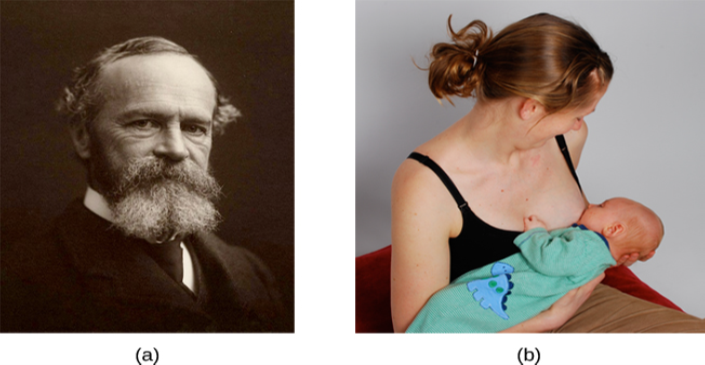
According to the drive theory of motivation, deviations from homeostasis create physiological needs. These needs result in psychological drive states that direct behavior to meet the need and, ultimately, bring the system back to homeostasis. For example, if it’s been a while since you ate, your blood sugar levels will drop below normal. This low blood sugar will induce a physiological need and a corresponding drive state (i.e., hunger) that will direct you to seek out and consume food (Figure 10.5). Eating will eliminate the hunger, and, ultimately, your blood sugar levels will return to normal. Interestingly, drive theory also emphasizes the role that habits play in the type of behavioral response in which we engage. A habit is a pattern of behavior in which we regularly engage. Once we have engaged in a behavior that successfully reduces a drive, we are more likely to engage in that behavior whenever faced with that drive in the future (Graham & Weiner, 1996).


But optimal arousal level is more complex than a simple answer that the middle level is always best. Researchers Robert Yerkes (pronounced “Yerk-EES”) and John Dodson discovered that the optimal arousal level depends on the complexity and difficulty of the task to be performed (Figure 10.7). This relationship is known as Yerkes-Dodson law, which holds that a simple task is performed best when arousal levels are relatively high and complex tasks are best performed when arousal levels are lower.
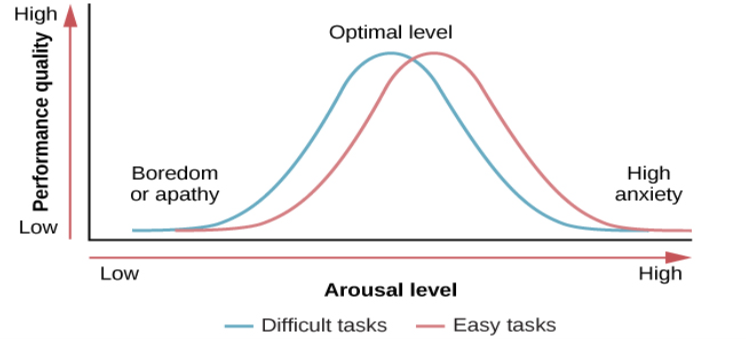
Self-efficacy and Social Motives
Self-efficacy is an individual’s belief in her own capability to complete a task, which may include a previous successful completion of the exact task or a similar task. Albert Bandura (1994) theorized that an individual’s sense of self-efficacy plays a pivotal role in motivating behavior. Bandura argues that motivation derives from expectations that we have about the consequences of our behaviors, and ultimately, it is the appreciation of our capacity to engage in a given behavior that will determine what we do and the future goals that we set for ourselves. For example, if you have a sincere belief in your ability to achieve at the highest level, you are more likely to take on challenging tasks and to not let setbacks dissuade you from seeing the task through to the end.
A number of theorists have focused their research on understanding social motives (McAdams & Constantian, 1983; McClelland & Liberman, 1949; Murray et al., 1938). Among the motives they describe are needs for achievement, affiliation, and intimacy. It is the need for achievement that drives accomplishment and performance. The need for affiliation encourages positive interactions with others, and the need for intimacy causes us to seek deep, meaningful relationships. Henry Murray et al. (1938) categorized these needs into domains. For example, the need for achievement and recognition falls under the domain of ambition. Dominance and aggression were recognized as needs under the domain of human power, and play was a recognized need in the domain of interpersonal affection.
Maslow’s Hierarchy of Needs
While the theories of motivation described earlier relate to basic biological drives, individual characteristics, or social contexts, Abraham Maslow (1943) proposed a hierarchy of needs that spans the spectrum of motives ranging from the biological to the individual to the social. These needs are often depicted as a pyramid (Figure 10.8).
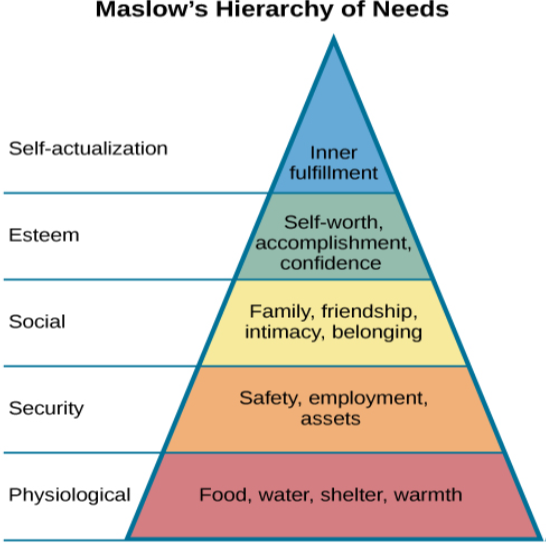
According to Maslow (1943), one must satisfy lower-level needs before addressing those needs that occur higher in the pyramid. So, for example, if someone is struggling to find enough food to meet his nutritional requirements, it is quite unlikely that he would spend an inordinate amount of time thinking about whether others viewed him as a good person or not. Instead, all of his energies would be geared toward finding something to eat. However, it should be pointed out that Maslow’s theory has been criticized for its subjective nature and its inability to account for phenomena that occur in the real world (Leonard, 1982). Other research has more recently addressed that late in life, Maslow proposed a self-transcendence level above self-actualization—to represent striving for meaning and purpose beyond the concerns of oneself (Koltko-Rivera, 2006). For example, people sometimes make self-sacrifices in order to make a political statement or in an attempt to improve the conditions of others. Mohandas K. Gandhi, a world-renowned advocate for independence through nonviolent protest, on several occasions went on hunger strikes to protest a particular situation. People may starve themselves or otherwise put themselves in danger displaying higher-level motives beyond their own needs.
10.1 TEST YOURSELF
10.2 Hunger and Eating
LEARNING OBJECTIVES
By the end of this section, you will be able to:
- Describe how hunger and eating are regulated
- Differentiate between levels of overweight and obesity and the associated health consequences
- Explain the health consequences resulting from anorexia and bulimia nervosa
Eating is essential for survival, and it is no surprise that a drive like hunger exists to ensure that we seek out sustenance. While this chapter will focus primarily on the physiological mechanisms that regulate hunger and eating, powerful social, cultural, and economic influences also play important roles. This section will explain the regulation of hunger, eating, and body weight, and we will discuss the adverse consequences of disordered eating.
Physiological Mechanisms
There are a number of physiological mechanisms that serve as the basis for hunger. When our stomachs are empty, they contract. Typically, a person then experiences hunger pangs. Chemical messages travel to the brain, and serve as a signal to initiate feeding behavior. When our blood glucose levels drop, the pancreas and liver generate a number of chemical signals that induce hunger (Konturek et al., 2003; Novin, Robinson, Culbreth, & Tordoff, 1985) and thus initiate feeding behavior.
For most people, once they have eaten, they feel satiation, or fullness and satisfaction, and their eating behavior stops. Like the initiation of eating, satiation is also regulated by several physiological mechanisms. As blood glucose levels increase, the pancreas and liver send signals to shut off hunger and eating (Drazen & Woods, 2003; Druce, Small, & Bloom, 2004; Greary, 1990). The food’s passage through the gastrointestinal tract also provides important satiety signals to the brain (Woods, 2004), and fat cells release leptin, a satiety hormone.
The various hunger and satiety signals that are involved in the regulation of eating are integrated in the brain. Research suggests that several areas of the hypothalamus and hindbrain are especially important sites where this integration occurs (Ahima & Antwi, 2008; Woods & D’Alessio, 2008). Ultimately, activity in the brain determines whether or not we engage in feeding behavior (Figure 10.9).
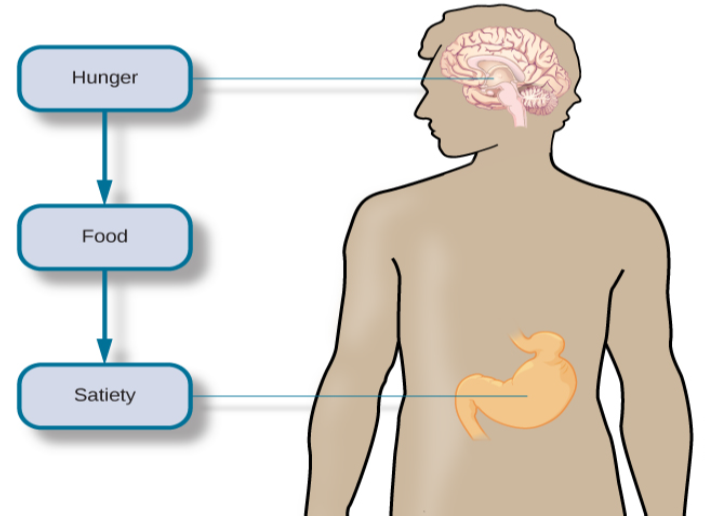
Metabolism and Body Weight
Our body weight is affected by a number of factors, including gene-environment interactions, and the number of calories we consume versus the number of calories we burn in daily activity. If our caloric intake exceeds our caloric use, our bodies store excess energy in the form of fat. If we consume fewer calories than we burn off, then stored fat will be converted to energy. Our energy expenditure is obviously affected by our levels of activity, but our body’s metabolic rate also comes into play. A person’s metabolic rate is the amount of energy that is expended in a given period of time, and there is tremendous individual variability in our metabolic rates. People with high rates of metabolism are able to burn off calories more easily than those with lower rates of metabolism.
We all experience fluctuations in our weight from time to time, but generally, most people’s weights fluctuate within a narrow margin, in the absence of extreme changes in diet and/or physical activity. This observation led some to propose a set-point theory of body weight regulation. The set-point theory asserts that each individual has an ideal body weight, or set point, which is resistant to change. This set-point is genetically predetermined and efforts to move our weight significantly from the set-point are resisted by compensatory changes in energy intake and/or expenditure (Speakman et al., 2011).
Some of the predictions generated from this particular theory have not received empirical support. For example, there are no changes in metabolic rate between individuals who had recently lost significant amounts of weight and a control group (Weinsier et al., 2000). In addition, the set-point theory fails to account for the influence of social and environmental factors in the regulation of body weight (Martin-Gronert & Ozanne, 2013; Speakman et al., 2011). Despite these limitations, set-point theory is still often used as a simple, intuitive explanation of how body weight is regulated. See Psychological Disorders for further discussion about eating disorders.
Obesity
When someone weighs more than what is generally accepted as healthy for a given height, they are considered overweight or obese. According to the Centers for Disease Control and Prevention (CDC), an adult with a body mass index (BMI) between 25 and 29.9 is considered overweight (Figure 10.10). An adult with a BMI of 30 or higher is considered obese (Centers for Disease Control and Prevention [CDC], 2012). People who are so overweight that they are at risk for death are classified as morbidly obese. Morbid obesity is defined as having a BMI over 40. Note that although BMI has been used as a healthy weight indicator by the World Health Organization (WHO), the CDC, and other groups, its value as an assessment tool has been questioned. The BMI is most useful for studying populations, which is the work of these organizations. It is less useful in assessing an individual since height and weight measurements fail to account for important factors like fitness level. An athlete, for example, may have a high BMI because the tool doesn’t distinguish between the body’s percentage of fat and muscle in a person’s weight.
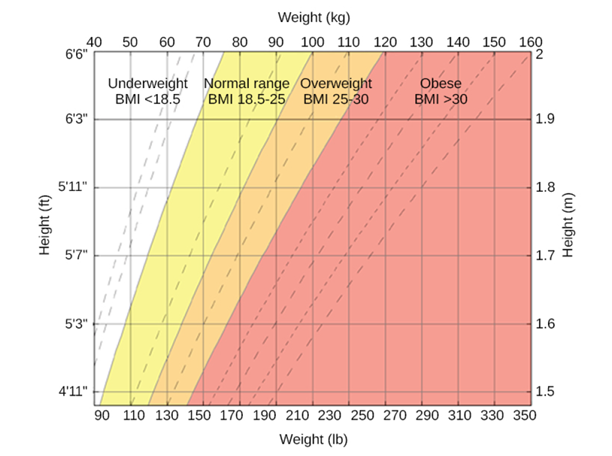
Being extremely overweight or obese is a risk factor for several negative health consequences. These include, but are not limited to, an increased risk for cardiovascular disease, stroke, Type 2 diabetes, liver disease, sleep apnea, colon cancer, breast cancer, infertility, and arthritis. Given that it is estimated that in the United States around one-third of the adult population is obese and that nearly two-thirds of adults and one in six children qualify as overweight (CDC, 2012), there is substantial interest in trying to understand how to combat this important public health concern.
What causes someone to be overweight or obese? You have already read that both genes and environment are important factors for determining body weight, and if more calories are consumed than expended, excess energy is stored as fat. However, socioeconomic status and the physical environment must also be considered as contributing factors (CDC, 2012). For example, an individual who lives in an impoverished neighborhood that is overrun with crime may never feel comfortable walking or biking to work or to the local market. This might limit the amount of physical activity in which he engages and result in an increased body weight. Similarly, some people may not be able to afford healthy food options from their market, or these options may be unavailable (especially in urban areas or poorer neighborhoods); therefore, some people rely primarily on available, inexpensive, high fat, and high calorie fast food as their primary source of nutrition.
Generally, overweight and obese individuals are encouraged to try to reduce their weights through a combination of both diet and exercise. While some people are very successful with these approaches, many struggle to lose excess weight. In cases in which a person has had no success with repeated attempts to reduce weight or is at risk for death because of obesity, bariatric surgery may be recommended. Bariatric surgery is a type of surgery specifically aimed at weight reduction, and it involves modifying the gastrointestinal system to reduce the amount of food that can be eaten and/or limiting how much of the digested food can be absorbed (Figure 10.11) (Mayo Clinic, 2013). A recent meta-analysis suggests that bariatric surgery is more effective than non-surgical treatment for obesity in the two-years immediately following the procedure, but to date, no long-term studies yet exist (Gloy et al., 2013).
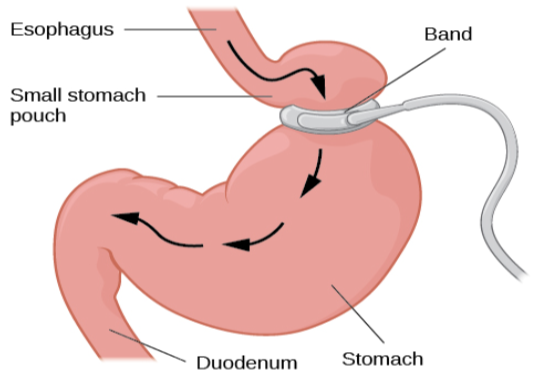
DIG DEEPER: Prader-Willi Syndrome
Prader-Willi Syndrome (PWS) is a genetic disorder that results in persistent feelings of intense hunger and reduced rates of metabolism. Typically, affected children have to be supervised around the clock to ensure that they do not engage in excessive eating. Currently, PWS is the leading genetic cause of morbid obesity in children, and it is associated with a number of cognitive deficits and emotional problems (Figure 10.12).

While the exact mechanisms of PWS are not fully understood, there is evidence that affected individuals have hypothalamic abnormalities. This is not surprising, given the hypothalamus’s role in regulating hunger and eating. However, as you will learn in the next section of this chapter, the hypothalamus is also involved in the regulation of sexual behavior. Consequently, many individuals suffering from PWS fail to reach sexual maturity during adolescence.
There is no current treatment or cure for PWS. However, if weight can be controlled in these individuals, then their life expectancies are significantly increased (historically, sufferers of PWS often died in adolescence or early adulthood). Advances in the use of various psychoactive medications and growth hormones continue to enhance the quality of life for individuals with PWS (Cassidy & Driscoll, 2009; Prader-Willi Syndrome Association, 2012).
Eating Disorders
While nearly two out of three US adults struggle with issues related to being overweight, a smaller, but significant, portion of the population has eating disorders that typically result in being normal weight or underweight. Often, these individuals are fearful of gaining weight. Individuals who suffer from bulimia nervosa and anorexia nervosa face many adverse health consequences (Mayo Clinic, 2012a, 2012b).
People suffering from bulimia nervosa engage in binge eating behavior that is followed by an attempt to compensate for the large amount of food consumed. Purging the food by inducing vomiting or through the use of laxatives are two common compensatory behaviors. Some affected individuals engage in excessive amounts of exercise to compensate for their binges. Bulimia is associated with many adverse health consequences that can include kidney failure, heart failure, and tooth decay. In addition, these individuals often suffer from anxiety and depression, and they are at an increased risk for substance abuse (Mayo Clinic, 2012b). The lifetime prevalence rate for bulimia nervosa is estimated at around 1% for women and less than 0.5% for men (Smink, van Hoeken, & Hoek, 2012).
As of the 2013 release of the Diagnostic and Statistical Manual, fifth edition, Binge eating disorder is a disorder recognized by the American Psychiatric Association (APA). Unlike with bulimia, eating binges are not followed by inappropriate behavior, such as purging, but they are followed by distress, including feelings of guilt and embarrassment. The resulting psychological distress distinguishes binge eating disorder from overeating (American Psychiatric Association [APA], 2013).
Anorexia nervosa is an eating disorder characterized by the maintenance of a body weight well below average through starvation and/or excessive exercise. Individuals suffering from anorexia nervosa often have a distorted body image, referenced in literature as a type of body dysmorphia, meaning that they view themselves as overweight even though they are not. Like bulimia nervosa, anorexia nervosa is associated with a number of significant negative health outcomes: bone loss, heart failure, kidney failure, amenorrhea (cessation of the menstrual period), reduced function of the gonads, and in extreme cases, death. Furthermore, there is an increased risk for a number of psychological problems, which include anxiety disorders, mood disorders, and substance abuse (Mayo Clinic, 2012a). Estimates of the prevalence of anorexia nervosa vary from study to study but generally range from just under one percent to just over four percent in women. Generally, prevalence rates are considerably lower for men (Smink et al., 2012).
While both anorexia and bulimia nervosa occur in men and women of many different cultures, Caucasian females from Western societies tend to be the most at-risk population. Recent research indicates that females between the ages of 15 and 19 are most at risk, and it has long been suspected that these eating disorders are culturally-bound phenomena that are related to messages of a thin ideal often portrayed in popular media and the fashion world (Figure 10.13) (Smink et al., 2012). While social factors play an important role in the development of eating disorders, there is also evidence that genetic factors may predispose people to these disorders (Collier & Treasure, 2004).

10.2 TEST YOURSELF
10.3 Sexual Behavior
LEARNING OBJECTIVES
By the end of this section, you will be able to:
- Understand basic biological mechanisms regulating sexual behavior and motivation
- Appreciate the importance of Alfred Kinsey’s research on human sexuality
- Recognize the contributions that William Masters and Virginia Johnson’s research made to our understanding of the sexual response cycle
- Define sexual orientation and gender identity
Like food, sex is an important part of our lives. From an evolutionary perspective, the reason is obvious—perpetuation of the species. Sexual behavior in humans, however, involves much more than reproduction. This section provides an overview of research that has been conducted on human sexual behavior and motivation. This section will close with a discussion of issues related to gender and sexual orientation.
Physiological Mechanisms of Sexual Behavior and Motivation
Much of what we know about the physiological mechanisms that underlie sexual behavior and motivation comes from animal research. As you’ve learned, the hypothalamus plays an important role in motivated behaviors, and sex is no exception. In fact, lesions to an area of the hypothalamus called the medial preoptic area completely disrupt a male rat’s ability to engage in sexual behavior. Surprisingly, medial preoptic lesions do not change how hard a male rat is willing to work to gain access to a sexually receptive female (Figure 10.14). This suggests that the ability to engage in sexual behavior and the motivation to do so may be mediated by neural systems distinct from one another.
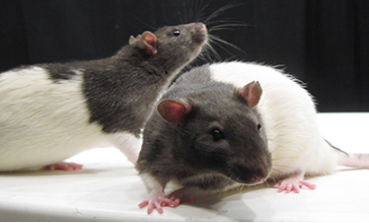
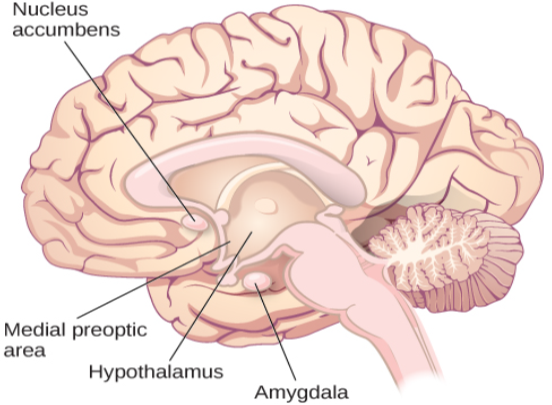
Kinsey’s Research
Before the late 1940s, access to reliable, empirically-based information on sex was limited. Physicians were considered authorities on all issues related to sex, despite the fact that they had little to no training in these issues, and it is likely that most of what people knew about sex had been learned either through their own experiences or by talking with their peers. Convinced that people would benefit from a more open dialogue on issues related to human sexuality, Dr. Alfred Kinsey of Indiana University initiated large-scale survey research on the topic (Figure 10.16). The results of some of these efforts were published in two books—Sexual Behavior in the Human Male and Sexual Behavior in the Human Female—which were published in 1948 and 1953, respectively (Bullough, 1998).

Although Kinsey’s research has been widely criticized as being riddled with sampling and statistical errors (Jenkins, 2010), there is little doubt that this research was very influential in shaping future research on human sexual behavior and motivation. Kinsey described a remarkably diverse range of sexual behaviors and experiences reported by the volunteers participating in his research. Behaviors that had once been considered exceedingly rare or problematic were demonstrated to be much more common and innocuous than previously imagined (Bancroft, 2004; Bullough, 1998).
Among the results of Kinsey’s research were the findings that women are as interested and experienced in sex as their male counterparts, that both males and females masturbate without adverse health consequences, and that homosexual acts are fairly common (Bancroft, 2004). Kinsey also developed a continuum known as the Kinsey scale that is still commonly used today to categorize an individual’s sexual orientation (Jenkins, 2010). According to that scale, sexual orientation is an individual’s emotional and erotic attractions to same-sexed individuals (homosexual), opposite-sexed individuals (heterosexual), or both (bisexual).
Masters and Johnson’s Research
In 1966, William Masters and Virginia Johnson published a book detailing the results of their observations of nearly 700 people who agreed to participate in their study of physiological responses during sexual behavior. Unlike Kinsey, who used personal interviews and surveys to collect data, Masters and Johnson observed people having intercourse in a variety of positions, and they observed people masturbating, manually or with the aid of a device. While this was occurring, researchers recorded measurements of physiological variables, such as blood pressure and respiration rate, as well as measurements of sexual arousal, such as vaginal lubrication and penile tumescence (swelling associated with an erection). In total, Masters and Johnson observed nearly 10,000 sexual acts as a part of their research (Hock, 2008).
Based on these observations, Masters and Johnson divided the sexual response cycle into four phases that are fairly similar in men and women: excitement, plateau, orgasm, and resolution (Figure 10.17). The excitement phase is the arousal phase of the sexual response cycle, and it is marked by erection of the penis or clitoris and lubrication and expansion of the vaginal canal. During plateau, women experience further swelling of the vagina and increased blood flow to the labia minora, and men experience full erection and often exhibit pre-ejaculatory fluid. Both men and women experience increases in muscle tone during this time. Orgasm is marked in women by rhythmic contractions of the pelvis and uterus along with increased muscle tension. In men, pelvic contractions are accompanied by a buildup of seminal fluid near the urethra that is ultimately forced out by contractions of genital muscles, (i.e., ejaculation). Resolution is the relatively rapid return to an unaroused state accompanied by a decrease in blood pressure and muscular relaxation. While many women can quickly repeat the sexual response cycle, men must pass through a longer refractory period as part of resolution. The refractory period is a period of time that follows an orgasm during which an individual is incapable of experiencing another orgasm. In men, the duration of the refractory period can vary dramatically from individual to individual with some refractory periods as short as several minutes and others as long as a day. As men age, their refractory periods tend to span longer periods of time.
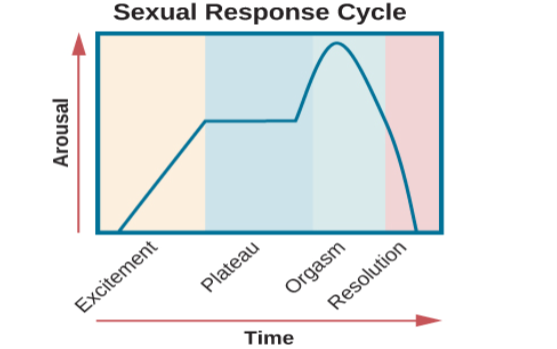
Sexual Orientation
As mentioned earlier, a person’s sexual orientation is their emotional and erotic attraction toward another individual (Figure 10.18). While the majority of people identify as heterosexual, there is a sizable population of people within the United States who identify as homosexual, bisexual, pansexual, asexual, or other non-hetero sexualities. Research suggests that somewhere between 3% and 10% of the population identifies as homosexual (Kinsey, Pomeroy, & Martin, 1948; LeVay, 1996; Pillard & Bailey, 1995). (Bisexual people are attracted to people of their own gender and another gender; pansexual people experience attraction without regard to sex, gender identity or gender expression; asexual people do not experience sexual attraction or have little or no interest in sexual activity.)

Genetic and biological mechanisms have also been proposed, and the balance of research evidence suggests that sexual orientation has an underlying biological component. For instance, over the past 25 years, research has demonstrated gene-level contributions to sexual orientation (Bailey & Pillard, 1991; Hamer, Hu, Magnuson, Hu, & Pattatucci, 1993; Rodriguez-Larralde & Paradisi, 2009), with some researchers estimating that genes account for at least half of the variability seen in human sexual orientation (Pillard & Bailey, 1998). Other studies report differences in brain structure and function between heterosexuals and homosexuals (Allen & Gorski, 1992; Byne et al., 2001; Hu et al., 2008; LeVay, 1991; Ponseti et al., 2006; Rahman & Wilson, 2003a; Swaab & Hofman, 1990), and even differences in basic body structure and function have been observed (Hall & Kimura, 1994; Lippa, 2003; Loehlin & McFadden, 2003; McFadden & Champlin, 2000; McFadden & Pasanen, 1998; Rahman & Wilson, 2003b). In aggregate, the data suggest that to a significant extent, sexual orientations are something with which we are born.
Misunderstandings About Sexual Orientation
Regardless of how sexual orientation is determined, research has made clear that sexual orientation is not a choice, but rather it is a relatively stable characteristic of a person that cannot be changed. Claims of successful gay conversion therapy have received wide criticism from the research community due to significant concerns with research design, recruitment of experimental participants, and interpretation of data. As such, there is no credible scientific evidence to suggest that individuals can change their sexual orientation (Jenkins, 2010).
Dr. Robert Spitzer, the author of one of the most widely-cited examples of successful conversion therapy, apologized to both the scientific community and the gay community for his mistakes, and he publically recanted his own paper in a public letter addressed to the editor of Archives of Sexual Behavior in the spring of 2012 (Carey, 2012). In this letter, Spitzer wrote,
I was considering writing something that would acknowledge that I now judge the major critiques of the study as largely correct. . . . I believe I owe the gay community an apology for my study making unproven claims of the efficacy of reparative therapy. I also apologize to any gay person who wasted time or energy undergoing some form of reparative therapy because they believed that I had proven that reparative therapy works with some “highly motivated” individuals. (Becker, 2012, pars. 2, 5)
Citing research that suggests not only that gay conversion therapy is ineffective, but also potentially harmful, legislative efforts to make such therapy illegal have either been enacted (e.g., it is now illegal in California) or are underway across the United States, and many professional organizations have issued statements against this practice (Human Rights Campaign, n.d.)
Gender Identity
Many people conflate sexual orientation with gender identity because of stereotypical attitudes that exist about gay and lesbian sexuality. In reality, these are two related, but different, issues. Gender identity refers to one’s sense of being male or female. Generally, our gender identities correspond to our chromosomal and phenotypic sex, but this is not always the case. When individuals do not feel comfortable identifying with the gender associated with their biological sex, then they experience gender dysphoria. Gender dysphoria is a diagnostic category in the fifth edition of the Diagnostic and Statistical Manual of Mental Disorders (DSM-5) that describes individuals who do not identify as the gender that most people would assume they are. This dysphoria must persist for at least six months and result in significant distress or dysfunction to meet DSM-5 diagnostic criteria. In order for children to be assigned this diagnostic category, they must verbalize their desire to become the other gender.
Many people who are classified as gender dysphoric seek to live their lives in ways that are consistent with their own gender identity. This involves dressing in opposite-sex clothing and assuming an opposite-sex identity. These individuals may also undertake transgender hormone therapy in an attempt to make their bodies look more like the opposite sex, and in some cases, they elect to have surgeries to alter the appearance of their external genitalia to resemble that of their gender identity (Figure 10.19). While these may sound like drastic changes, gender dysphoric individuals take these steps because their bodies seem to them to be a mistake of nature, and they seek to correct this mistake.
Our scientific knowledge and general understanding about gender identity continue to evolve, and young people today have more opportunity to explore and openly express different ideas about what gender means than previous generations. Recent studies indicate that that majority of millennials (those ages 18–34) regard gender as a spectrum instead of a strict male/female binary, and that 12% identify as transgender or gender non-conforming. Additionally, over half of people ages 13–20 know people who use gender-neutral pronouns (such as they/them) (Kennedy, 2017). This change in language means that millennials and Generation Z people understand the experience of gender itself differently. As young people lead this change, other changes are emerging in a range of spheres, from public bathroom policies to retail organizations. For example, some retailers are starting to change traditional gender-based marketing of products, such as removing “pink and blue” clothing and toy aisles. Even with these changes, those who exist outside of traditional gender norms face difficult challenges. Even people who vary slightly from traditional norms can be the target of discrimination and sometimes even violence.

Cultural Factors in Sexual Orientation and Gender Identity
Issues related to sexual orientation and gender identity are very much influenced by sociocultural factors. Even the ways in which we define sexual orientation and gender vary from one culture to the next. While in the United States heterosexuality has historically been viewed as the norm, there are societies that have different attitudes regarding gay behavior. In fact, in some instances, periods of exclusively homosexual behavior are socially prescribed as a part of normal development and maturation. For example, in parts of New Guinea, young boys are expected to engage in sexual behavior with other boys for a given period of time because it is believed that doing so is necessary for these boys to become men (Baldwin & Baldwin, 1989).
There has historically been a two-gendered culture in the United States. We have tended to classify an individual as either male or female. However, in some cultures there are additional gender variants resulting in more than two gender categories. For example, in Thailand, you can be male, female, or kathoey. A kathoey is an individual who would be described as intersexed or transgender in the United States (Tangmunkongvorakul, Banwell, Carmichael, Utomo, & Sleigh, 2010). Intersex is a broad term referring to people whose bodies are not strictly biologically male or female (Hughes, et al. 2006). Intersex conditions can present at any time during life (Creighton, 2001). Sometimes a child may be born with components of male and female genitals, and other times XY chromosomal differences are present (Creighton, 2001; Hughes, et al. 2006).
DIG DEEPER
The Case of David Reimer
In August of 1965, Janet and Ronald Reimer of Winnipeg, Canada, welcomed the birth of their twin sons, Bruce and Brian. Within a few months, the twins were experiencing urinary problems; doctors recommended the problems could be alleviated by having the boys circumcised. A malfunction of the medical equipment used to perform the circumcision resulted in Bruce’s penis being irreparably damaged. Distraught, Janet and Ronald looked to expert advice on what to do with their baby boy. By happenstance, the couple became aware of Dr. John Money at Johns Hopkins University and his theory of psychosexual neutrality (Colapinto, 2000).
Dr. Money had spent a considerable amount of time researching transgender individuals and individuals born with ambiguous genitalia. As a result of this work, he developed a theory of psychosexual neutrality. His theory asserted that we are essentially neutral at birth with regard to our gender identity and that we don’t assume a concrete gender identity until we begin to master language. Furthermore, Dr. Money believed that the way in which we are socialized in early life is ultimately much more important than our biology in determining our gender identity (Money, 1962).
Dr. Money encouraged Janet and Ronald to bring the twins to Johns Hopkins University, and he convinced them that they should raise Bruce as a girl. Left with few other options at the time, Janet and Ronald agreed to have Bruce’s testicles removed and to raise him as a girl. When they returned home to Canada, they brought with them Brian and his “sister,” Brenda, along with specific instructions to never reveal to Brenda that she had been born a boy (Colapinto, 2000).
Early on, Dr. Money shared with the scientific community the great success of this natural experiment that seemed to fully support his theory of psychosexual neutrality (Money, 1975). Indeed, in early interviews with the children it appeared that Brenda was a typical little girl who liked to play with “girly” toys and do “girly” things.
However, Dr. Money was less than forthcoming with information that seemed to argue against the success of the case. In reality, Brenda’s parents were constantly concerned that their little girl wasn’t really behaving as most girls did, and by the time Brenda was nearing adolescence, it was painfully obvious to the family that she was really having a hard time identifying as a female. In addition, Brenda was becoming increasingly reluctant to continue her visits with Dr. Money to the point that she threatened suicide if her parents made her go back to see him again.
At that point, Janet and Ronald disclosed the true nature of Brenda’s early childhood to their daughter. While initially shocked, Brenda reported that things made sense to her now, and ultimately, by the time she was an adolescent, Brenda had decided to identify as a male. Thus, she became David Reimer.
David was quite comfortable in his masculine role. He made new friends and began to think about his future. Although his castration had left him infertile, he still wanted to be a father. In 1990, David married a single mother and loved his new role as a husband and father. In 1997, David was made aware that Dr. Money was continuing to publicize his case as a success supporting his theory of psychosexual neutrality. This prompted David and his brother to go public with their experiences in attempt to discredit the doctor’s publications. While this revelation created a firestorm in the scientific community for Dr. Money, it also triggered a series of unfortunate events that ultimately led to David committing suicide in 2004 (O’Connell, 2004).
This sad story speaks to the complexities involved in gender identity. While the Reimer case had earlier been paraded as a hallmark of how socialization trumped biology in terms of gender identity, the truth of the story made the scientific and medical communities more cautious in dealing with cases that involve intersex children and how to deal with their unique circumstances. In fact, stories like this one have prompted measures to prevent unnecessary harm and suffering to children who might have issues with gender identity. For example, in 2013, a law took effect in Germany allowing parents of intersex children to classify their children as indeterminate so that children can self-assign the appropriate gender once they have fully developed their own gender identities (Paramaguru, 2013).
10.3 TEST YOURSELF
10.4 Emotion
Learning Objectives
By the end of this section, you will be able to:
- Explain the major theories of emotion
- Describe the role that limbic structures play in emotional processing
- Understand the ubiquitous nature of producing and recognizing emotional expression
As we move through our daily lives, we experience a variety of emotions. An emotion is a subjective state of being that we often describe as our feelings. Emotions result from the combination of subjective experience, expression, cognitive appraisal, and physiological responses (Levenson, Carstensen, Friesen, & Ekman, 1991). However, as discussed later in the chapter, the exact order in which the components occur is not clear, and some parts may happen at the same time. An emotion often begins with a subjective (individual) experience, which is a stimulus. Often the stimulus is external, but it does not have to be from the outside world. For example, it might be that one thinks about war and becomes sad, even though he or she never experienced war. Emotional expression refers to the way one displays an emotion and includes nonverbal and verbal behaviors (Gross, 1999). One also performs a cognitive appraisal in which a person tries to determine the way he or she will be impacted by a situation (Roseman & Smith, 2001). In addition, emotions include physiological responses, such as possible changes in heart rate, sweating, etc. (Soussignan, 2002).
The words emotion and mood are sometimes used interchangeably, but psychologists use these words to refer to two different things. Typically, the word emotion indicates a subjective, affective state that is relatively intense and that occurs in response to something we experience (Figure 10.20). Emotions are often thought to be consciously experienced and intentional. Mood, on the other hand, refers to a prolonged, less intense, affective state that does not occur in response to something we experience. Mood states may not be consciously recognized and do not carry the intentionality that is associated with emotion (Beedie, Terry, Lane, & Devonport, 2011). Here we will focus on emotion, and you will learn more about mood in the chapter that covers psychological disorders.
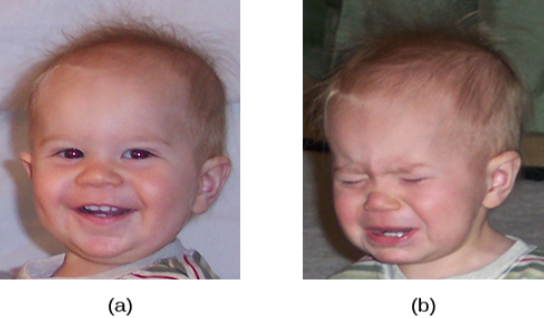
Theories of Emotion
Our emotional states are combinations of physiological arousal, psychological appraisal, and subjective experiences. Together, these are the components of emotion, and our experiences, backgrounds, and cultures inform our emotions. Therefore, different people may have different emotional experiences even when faced with similar circumstances. Over time, several different theories of emotion, shown in Figure 10.21, have been proposed to explain how the various components of emotion interact with one another.
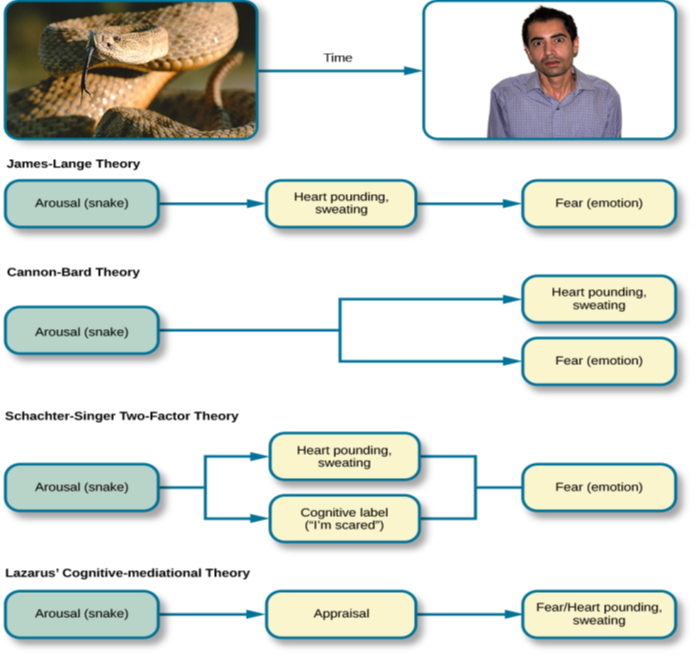
Other theorists, however, doubted that the physiological arousal that occurs with different types of emotions is distinct enough to result in the wide variety of emotions that we experience. Thus, the Cannon-Bard theory of emotion was developed. According to this view, physiological arousal and emotional experience occur simultaneously, yet independently (Lang, 1994). So, when you see the venomous snake, you feel fear at exactly the same time that your body mounts its fight or flight response. This emotional reaction would be separate and independent of the physiological arousal, even though they co-occur.
Does smiling make you happy? Alternatively, does being happy make you smile? The facial feedback hypothesis proposes that your facial expression can actually affect your emotional experience (Adelman & Zajonc, 1989; Boiger & Mesquita, 2012; Buck, 1980; Capella, 1993; Soussignan, 2001; Strack, Martin, & Stepper, 1988). Research investigating the facial feedback hypothesis suggested that suppression of facial expression of emotion lowered the intensity of some emotions experienced by participants (Davis, Senghas, & Ochsner, 2009). Havas, Glenberg, Gutowski, Lucarelli, and Davidson (2010) used Botox injections to paralyze facial muscles and limit facial expressions, including frowning, and they found that depressed people reported less depression after their frowning muscles were paralyzed. Other research found that the intensities of facial expressions affected the emotional reactions (Soussignan, 2002; Strack, Martin, & Stepper, 1988). In other words, if something insignificant occurs and you smile as if you just won lottery, you will actually be happier about the little thing than you would be if you only had a tiny smile. Conversely, if you walk around frowning all the time, it might cause you to have less positive emotions than you would if you had smiled. Interestingly, Soussignan (2002) also reported physiological arousal differences associated with the intensities of one type of smile.
G. Marañon Posadillo was a Spanish physician who studied the psychological effects of adrenaline to create a model for the experience of emotion. Marañon’s model preceded Schachter’s two-factor or arousal-cognition theory of emotion (Cornelius, 1991). The Schachter-Singer two-factor theory of emotion is another variation on theories of emotions that takes into account both physiological arousal and the emotional experience. According to this theory, emotions are composed of two factors: physiological and cognitive. In other words, physiological arousal is interpreted in context to produce the emotional experience. In revisiting our example involving the venomous snake in your backyard, the two-factor theory maintains that the snake elicits sympathetic nervous system activation that is labeled as fear given the context, and our experience is that of fear. If you had labeled your sympathetic nervous system activation as joy, you would have experienced joy. The Schachter-Singer two-factor theory depends on labeling the physiological experience, which is a type of cognitive appraisal.
Magda Arnold was the first theorist to offer an exploration of the meaning of appraisal, and to present an outline of what the appraisal process might be and how it relates to emotion (Roseman & Smith, 2001). The key idea of appraisal theory is that you have thoughts (a cognitive appraisal) before you experience an emotion, and the emotion you experience depends on the thoughts you had (Frijda, 1988; Lazarus, 1991). If you think something is positive, you will have more positive emotions about it than if your appraisal was negative, and the opposite is true. Appraisal theory explains the way two people can have two completely different emotions regarding the same event. For example, suppose your psychology instructor selected you to lecture on emotion; you might see that as positive, because it represents an opportunity to be the center of attention, and you would experience happiness. However, if you dislike speaking in public, you could have a negative appraisal and experience discomfort.
Schachter and Singer believed that physiological arousal is very similar across the different types of emotions that we experience, and therefore, the cognitive appraisal of the situation is critical to the actual emotion experienced. In fact, it might be possible to misattribute arousal to an emotional experience if the circumstances were right (Schachter & Singer, 1962). They performed a clever experiment to test their idea. Male participants were randomly assigned to one of several groups. Some of the participants received injections of epinephrine that caused bodily changes that mimicked the fight-or-flight response of the sympathetic nervous system; however, only some of these men were told to expect these reactions as side effects of the injection. The other men that received injections of epinephrine were told either that the injection would have no side effects or that it would result in a side effect unrelated to a sympathetic response, such as itching feet or headache. After receiving these injections, participants waited in a room with someone else they thought was another subject in the research project. In reality, the other person was a confederate of the researcher. The confederate engaged in scripted displays of euphoric or angry behavior (Schachter & Singer, 1962).
When those participants who were told that they should expect to feel symptoms of physiological arousal were asked about any emotional changes that they had experienced related to either euphoria or anger (depending on the way the confederate behaved), they reported none. However, the men who weren’t expecting physiological arousal as a function of the injection were more likely to report that they experienced euphoria or anger as a function of their assigned confederate’s behavior. While everyone who received an injection of epinephrine experienced the same physiological arousal, only those who were not expecting the arousal used context to interpret the arousal as a change in emotional state (Schachter & Singer, 1962).
Strong emotional responses are associated with strong physiological arousal, which caused some theorists to suggest that the signs of physiological arousal, including increased heart rate, respiration rate, and sweating, might be used to determine whether someone is telling the truth or not. The assumption is that most of us would show signs of physiological arousal if we were being dishonest with someone. A polygraph, or lie detector test, measures the physiological arousal of an individual responding to a series of questions. Someone trained in reading these tests would look for answers to questions that are associated with increased levels of arousal as potential signs that the respondent may have been dishonest on those answers. While polygraphs are still commonly used, their validity and accuracy are highly questionable because there is no evidence that lying is associated with any particular pattern of physiological arousal (Saxe & Ben-Shakhar, 1999).
The relationship between our experiencing of emotions and our cognitive processing of them, and the order in which these occur, remains a topic of research and debate. Lazarus (1991) developed the cognitive-mediational theory that asserts our emotions are determined by our appraisal of the stimulus. This appraisal mediates between the stimulus and the emotional response, and it is immediate and often unconscious. In contrast to the Schachter-Singer model, the appraisal precedes a cognitive label. You will learn more about Lazarus’s appraisal concept when you study stress, health, and lifestyle. However, there are other views of emotions that also emphasize the cognitive processes.
Return to the example of being asked to lecture by your professor. Even if you do not enjoy speaking in public, you probably could manage to do it. You would purposefully control your emotions, which would allow you to speak, but we constantly regulate our emotions, and much of our emotion regulation occurs without us actively thinking about it. Mauss and her colleagues studied automatic emotion regulation (AER), which refers to the non-deliberate control of emotions. It is simply not reacting with your emotions, and AER can affect all aspects of emotional processes. AER can influence the things you attend to, your appraisal, your choice to engage in an emotional experience, and your behaviors after an emotion is experienced (Mauss, Bunge, & Gross, 2007; Mauss, Levenson, McCarter, Wilhelm, & Gross, 2005). AER is similar to other automatic cognitive processes in which sensations activate knowledge structures that affect functioning. These knowledge structures can include concepts, schemas, or scripts.
The idea of AER is that people develop an automatic process that works like a script or schema, and the process does not require deliberate thought to regulate emotions. AER works like riding a bicycle. Once you develop the process, you just do it without thinking about it. AER can be adaptive or maladaptive and has important health implications (Hopp, Troy, & Mauss, 2011). Adaptive AER leads to better health outcomes than maladaptive AER, primarily due to experiencing or mitigating stressors better than people with maladaptive AERs (Hopp, Troy, & Mauss, 2011). Alternatively, maladaptive AERs may be critical for maintaining some psychological disorders (Hopp, Troy, & Mauss, 2011). Mauss and her colleagues found that strategies could reduce negative emotions, which in turn should increase psychological health (Mauss, Cook, Cheng, & Gross, 2007; Mauss, Cook, & Gross, 2007; Shallcross, Troy, Boland, & Mauss, 2010; Troy, Shallcross, & Mauss, 2013; Troy, Wilhelm, Shallcross, & Mauss, 2010). Mauss has also suggested there are problems with the way emotions are measured, but she believes most of the aspects of emotions that are typically measured are useful (Mauss, et al., 2005; Mauss & Robinson, 2009). However, another way of considering emotions challenges our entire understanding of emotions.
After about three decades of interdisciplinary research, Barrett argued that we do not understand emotions. She proposed that emotions were not built into your brain at birth, but rather they were constructed based on your experiences. Emotions in the constructivist theory are predictions that construct your experience of the world. In chapter 7 you learned that concepts are categories or groupings of linguistic information, images, ideas, or memories, such as life experiences. Barrett extended that to include emotions as concepts that are predictions (Barrett, 2017). Two identical physiological states can result in different emotional states depending on your predictions. For example, your brain predicting a churning stomach in a bakery could lead to you constructing hunger. However, your brain predicting a churning stomach while you were waiting for medical test results could lead your brain to construct worry. Thus, you can construct two different emotions from the same physiological sensations. Rather than emotions being something over which you have no control, you can control and influence your emotions.
Two other prominent views arise from the work of Robert Zajonc and Joseph LeDoux. Zajonc asserted that some emotions occur separately from or prior to our cognitive interpretation of them, such as feeling fear in response to an unexpected loud sound (Zajonc, 1998). He also believed in what we might casually refer to as a gut feeling—that we can experience an instantaneous and unexplainable like or dislike for someone or something (Zajonc, 1980). LeDoux also views some emotions as requiring no cognition: some emotions completely bypass contextual interpretation. His research into the neuroscience of emotion has demonstrated the amygdala’s primary role in fear (Cunha, Monfils, & LeDoux, 2010; LeDoux 1996, 2002). A fear stimulus is processed by the brain through one of two paths: from the thalamus (where it is perceived) directly to the amygdala or from the thalamus through the cortex and then to the amygdala. The first path is quick, while the second enables more processing about details of the stimulus. In the following section, we will look more closely at the neuroscience of emotional response.
The Biology of Emotions
Earlier, you learned about the limbic system, which is the area of the brain involved in emotion and memory (Figure 10.22). The limbic system includes the hypothalamus, thalamus, amygdala, and the hippocampus. The hypothalamus plays a role in the activation of the sympathetic nervous system that is a part of any given emotional reaction. The thalamus serves as a sensory relay center whose neurons project to both the amygdala and the higher cortical regions for further processing. The amygdala plays a role in processing emotional information and sending that information on (Fossati, 2012).The hippocampus integrates emotional experience with cognition (Femenía, Gómez-Galán, Lindskog, & Magara, 2012).

Amygdala
The amygdala has received a great deal of attention from researchers interested in understanding the biological basis for emotions, especially fear and anxiety (Blackford & Pine, 2012; Goosens & Maren, 2002; Maren, Phan, & Liberzon, 2013). The amygdala is composed of various subnuclei, including the basolateral complex and the central nucleus (Figure 10.23). The basolateral complex has dense connections with a variety of sensory areas of the brain. It is critical for classical conditioning and for attaching emotional value to learning processes and memory. The central nucleus plays a role in attention, and it has connections with the hypothalamus and various brainstem areas to regulate the autonomic nervous and endocrine systems’ activity (Pessoa, 2010).
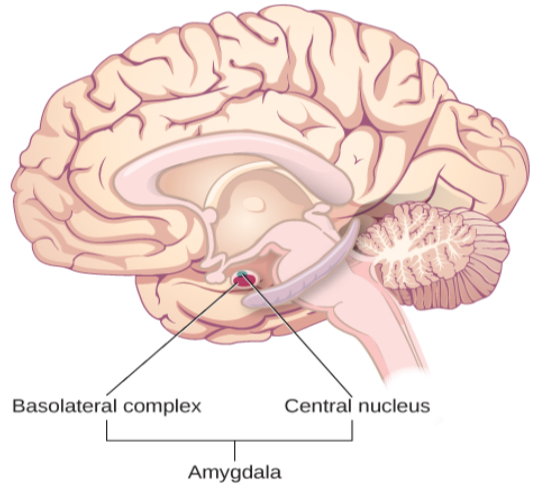
Raineki, Cortés, Belnoue, and Sullivan (2012) demonstrated that, in rats, negative early life experiences could alter the function of the amygdala and result in adolescent patterns of behavior that mimic human mood disorders. In this study, rat pups received either abusive or normal treatment during postnatal days 8–12. There were two forms of abusive treatment. The first form of abusive treatment had an insufficient bedding condition. The mother rat had insufficient bedding material in her cage to build a proper nest that resulted in her spending more time away from her pups trying to construct a nest and less times nursing her pups. The second form of abusive treatment had an associative learning task that involved pairing odors and an electrical stimulus in the absence of the mother, as described above. The control group was in a cage with sufficient bedding and was left undisturbed with their mothers during the same time period. The rat pups that experienced abuse were much more likely to exhibit depressive-like symptoms during adolescence when compared to controls. These depressive-like behaviors were associated with increased activation of the amygdala.
Human research also suggests a relationship between the amygdala and psychological disorders of mood or anxiety. Changes in amygdala structure and function have been demonstrated in adolescents who are either at-risk or have been diagnosed with various mood and/or anxiety disorders (Miguel-Hidalgo, 2013; Qin et al., 2013). It has also been suggested that functional differences in the amygdala could serve as a biomarker to differentiate individuals suffering from bipolar disorder from those suffering from major depressive disorder (Fournier, Keener, Almeida, Kronhaus, & Phillips, 2013).
Hippocampus
As mentioned earlier, the hippocampus is also involved in emotional processing. Like the amygdala, research has demonstrated that hippocampal structure and function are linked to a variety of mood and anxiety disorders. Individuals suffering from posttraumatic stress disorder (PTSD) show marked reductions in the volume of several parts of the hippocampus, which may result from decreased levels of neurogenesis and dendritic branching (the generation of new neurons and the generation of new dendrites in existing neurons, respectively) (Wang et al., 2010). While it is impossible to make a causal claim with correlational research like this, studies have demonstrated behavioral improvements and hippocampal volume increases following either pharmacological or cognitive-behavioral therapy in individuals suffering from PTSD (Bremner & Vermetten, 2004; Levy-Gigi, Szabó, Kelemen, & Kéri, 2013).
Facial Expression and Recognition of Emotions
Culture can impact the way in which people display emotion. A cultural display rule is one of a collection of culturally specific standards that govern the types and frequencies of displays of emotions that are acceptable (Malatesta & Haviland, 1982). Therefore, people from varying cultural backgrounds can have very different cultural display rules of emotion. For example, research has shown that individuals from the United States express negative emotions like fear, anger, and disgust both alone and in the presence of others, while Japanese individuals only do so while alone (Matsumoto, 1990). Furthermore, individuals from cultures that tend to emphasize social cohesion are more likely to engage in suppression of emotional reaction so they can evaluate which response is most appropriate in a given context (Matsumoto, Yoo, & Nakagawa, 2008).
Other distinct cultural characteristics might be involved in emotionality. For instance, there may be gender differences involved in emotional processing. While research into gender differences in emotional display is equivocal, there is some evidence that men and women may differ in regulation of emotions (McRae, Ochsner, Mauss, Gabrieli, & Gross, 2008).
Paul Ekman (1972) researched a New Guinea man who was living in a preliterate culture using stone implements, and which was isolated and had never seen any outsiders before. Ekman asked the man to show what his facial expression would be if: (1) friends visited, (2) his child had just died, (3) he was about to fight, (4) he stepped on a smelly dead pig. After Ekman’s return from New Guinea, he researched facial expressions for more than four decades. Despite different emotional display rules, our ability to recognize and produce facial expressions of emotion appears to be universal. In fact, even congenitally blind individuals produce the same facial expression of emotions, despite their never having the opportunity to observe these facial displays of emotion in other people. This would seem to suggest that the pattern of activity in facial muscles involved in generating emotional expressions is universal, and indeed, this idea was suggested in the late 19th century in Charles Darwin’s book The Expression of Emotions in Man and Animals (1872). In fact, there is substantial evidence for seven universal emotions that are each associated with distinct facial expressions. These include: happiness, surprise, sadness, fright, disgust, contempt, and anger (Figure 10.24) (Ekman & Keltner, 1997).
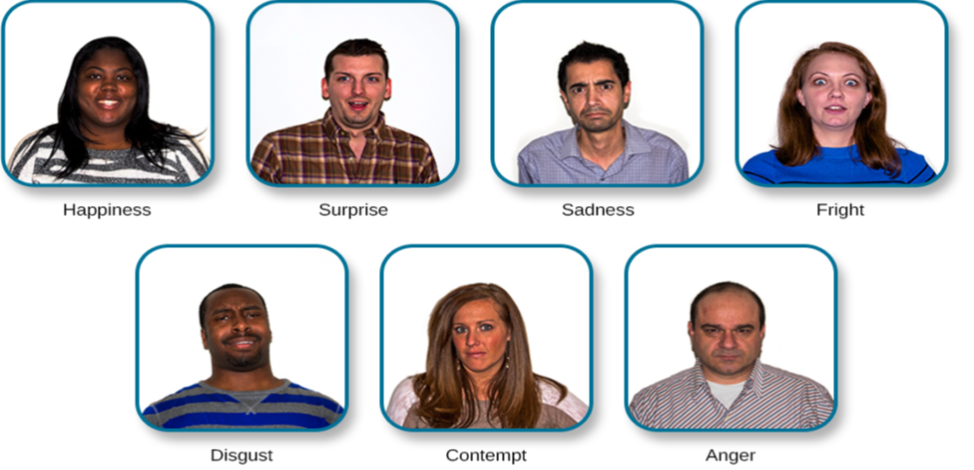
CONNECT THE CONCEPTS
Emotional Expression and Emotion Regulation
Autism spectrum disorder (ASD) is a set of neurodevelopmental disorders characterized by repetitive behaviors and communication and social problems. Children who have autism spectrum disorders have difficulty recognizing the emotional states of others, and research has shown that this may stem from an inability to distinguish various nonverbal expressions of emotion (i.e., facial expressions) from one another (Hobson, 1986). In addition, there is evidence to suggest that autistic individuals also have difficulty expressing emotion through tone of voice and by producing facial expressions (Macdonald et al., 1989). Difficulties with emotional recognition and expression may contribute to the impaired social interaction and communication that characterize autism; therefore, various therapeutic approaches have been explored to address these difficulties. Various educational curricula, cognitive-behavioral therapies, and pharmacological therapies have shown some promise in helping autistic individuals process emotionally relevant information (Bauminger, 2002; Golan & Baron-Cohen, 2006; Guastella et al., 2010).
Emotion regulation describes how people respond to situations and experiences by modifying their emotional experiences and expressions. Covert emotion regulation strategies are those that occur within the individual, while overt strategies involve others or actions (such as seeking advice or consuming alcohol). Aldao and Dixon (2014) studied the relationship between overt emotional regulation strategies and psychopathology. They researched how 218 undergraduate students reported their use of covert and overt strategies and their reported symptoms associated with selected mental disorders, and found that overt emotional regulation strategies were better predictors of psychopathology than covert strategies. Another study examined the relationship between pregaming (the act of drinking heavily before a social event) and two emotion regulation strategies to understand how these might contribute to alcohol-related problems; results suggested a relationship but a complicated one (Pederson, 2016). Further research is needed in these areas to better understand patterns of adaptive and maladaptive emotion regulation (Aldao & Dixon-Gordon, 2014).
10.4 TEST YOURSELF
Summary
10.1 Motivation
Motivation to engage in a given behavior can come from internal and/or external factors. Multiple theories have been put forward regarding motivation. More biologically oriented theories deal with the ways that instincts and the need to maintain bodily homeostasis motivate behavior. Bandura postulated that our sense of self-efficacy motivates behaviors, and there are a number of theories that focus on a variety of social motives. Abraham Maslow’s hierarchy of needs is a model that shows the relationship among multiple motives that range from lower-level physiological needs to the very high level of self-actualization.
10.2 Hunger and Eating
Hunger and satiety are highly regulated processes that result in a person maintaining a fairly stable weight that is resistant to change. When more calories are consumed than expended, a person will store excess energy as fat. Being significantly overweight adds substantially to a person’s health risks and problems, including cardiovascular disease, type 2 diabetes, certain cancers, and other medical issues. Sociocultural factors that emphasize thinness as a beauty ideal and a genetic predisposition contribute to the development of eating disorders in many young females, though eating disorders span ages and genders.
10.3 Sexual Behavior
The hypothalamus and structures of the limbic system are important in sexual behavior and motivation. There is evidence to suggest that our motivation to engage in sexual behavior and our ability to do so are related, but separate, processes. Alfred Kinsey conducted large-scale survey research that demonstrated the incredible diversity of human sexuality. William Masters and Virginia Johnson observed individuals engaging in sexual behavior in developing their concept of the sexual response cycle. While often interchanged, sexual orientation and gender identity are related, but distinct, concepts.
10.4 Emotion
Emotions are subjective experiences that consist of physiological arousal and cognitive appraisal. Various theories have been put forward to explain our emotional experiences. The James-Lange theory asserts that emotions arise as a function of physiological arousal. The Cannon-Bard theory maintains that emotional experience occurs simultaneous to and independent of physiological arousal. The Schachter-Singer two-factor theory suggests that physiological arousal receives cognitive labels as a function of the relevant context and that these two factors together result in an emotional experience.
The limbic system is the brain’s emotional circuit, which includes the amygdala and the hippocampus. Both of these structures are implicated in playing a role in normal emotional processing as well as in psychological mood and anxiety disorders. Increased amygdala activity is associated with learning to fear, and it is seen in individuals who are at risk for or suffering from mood disorders. The volume of the hippocampus has been shown to be reduced in individuals suffering from posttraumatic stress disorder.
The ability to produce and recognize facial expressions of emotions seems to be universal regardless of cultural background. However, there are cultural display rules which influence how often and under what circumstances various emotions can be expressed. Tone of voice and body language also serve as a means by which we communicate information about our emotional states.
Critical Thinking Questions
- How might someone espousing an arousal theory of motivation explain visiting an amusement park?
- Schools often use concrete rewards to increase adaptive behaviors. How might this be a disadvantage for students intrinsically motivated to learn? What are educational implications of the potential for concrete rewards to diminish intrinsic motivation for a given task?
- The index that is often used to classify people in terms of weight and body fat is called BMI. Given that BMI is calculated solely on weight and height, how could it be misleading?
- As indicated in this section, White women from industrialized, Western cultures tend to be at the highest risk for eating disorders like anorexia and bulimia nervosa. Why might this be?
- While much research has been conducted on how an individual develops a given sexual orientation, many people question the validity of this research citing that the participants used may not be representative. Why do you think this might be a legitimate concern?
- There is no reliable scientific evidence that conversion therapy actually works. What kinds of evidence would you need to see in order to be convinced by someone arguing that they had successfully converted their sexual orientation?
- Imagine you find a venomous snake crawling up your leg just after taking a drug that prevented sympathetic nervous system activation. What would the James-Lange theory predict about your experience?
- Why can we not make causal claims regarding the relationship between the volume of the hippocampus and PTSD?
Personal Application Questions
- Can you think of recent examples of how Maslow’s hierarchy of needs might have affected your behavior in some way?
- Producers of popular movies and series typically indicate that they have increased representation regarding people of different sizes, sexual orientations, gender expressions, and abilities. Do you think that is true? Is representation a way to support diverse people?
- In 2020 the U.S. Supreme Court ruled that the Civil Rights Act must apply workplace protections to people regardless of sexual orientation, gender identity, or gender expression. Do you think the ruling has—or will—result in improved overall acceptance and opportunities for LGBTQ people?
- Think about times in your life when you have been absolutely elated (e.g., perhaps your school’s basketball team just won a closely contested ballgame for the national championship) and very fearful (e.g., you are about to give a speech in your public speaking class to a roomful of 100 strangers). How would you describe how your arousal manifested itself physically? Were there marked differences in physiological arousal associated with each emotional state?
Access for free at https://openstax.org/books/psychology-2e/pages/1-introduction
wants or needs that direct behavior toward some goal
motivation based on internal feelings rather than external rewards
motivation that arises from external factors or rewards
species-specific pattern of behavior that is unlearned
deviations from homeostasis create physiological needs that result in psychological drive states that direct behavior to meet the need and ultimately bring the system back to homeostasis
simple tasks are performed best when arousal levels are relatively high, while complex tasks are best performed when arousal is lower
individual’s belief in their own capabilities or capacities to complete a task
spectrum of needs ranging from basic biological needs to social needs to self-actualization
fullness; satisfaction
satiety hormone
assertion that each individual has an ideal body weight, or set point, that is resistant to change
type of surgery that modifies the gastrointestinal system to reduce the amount of food that can be eaten and/or limiting how much of the digested food can be absorbed
type of eating disorder characterized by binge eating followed by purging
type of eating disorder characterized by binge eating and associated distress
eating disorder characterized by an individual maintaining body weight that is well below average through starvation and/or excessive exercise
emotional, romantic, and/or erotic attraction to other people or no people
phase of the sexual response cycle that involves sexual arousal
phase of the sexual response cycle that falls between excitement and orgasm
peak phase of the sexual response cycle associated with rhythmic muscle contractions (and ejaculation)
phase of the sexual response cycle following orgasm during which the body returns to its unaroused state
emotional, romantic, and/or erotic attractions to opposite-sex individuals
emotional, romantic, and/or erotic attraction to those of the same gender or to those of another gender
individual’s sense of being male, female, neither of these, both of these, or another gender
diagnostic category in DSM-5 for individuals who experience enduring distress as a result of their gender identity not aligning with their sex assigned at birth
use of hormones to make one’s body look more like a different sex or gender
subjective state of being often described as feelings
emotions arise from physiological arousal
physiological arousal and emotional experience occur at the same time
facial expressions are capable of influencing our emotions
emotions consist of two factors: physiological and cognitive
our emotions are determined by our appraisal of the stimulus
part of the brain with dense connections with a variety of sensory areas of the brain; it is critical for classical conditioning and attaching emotional value to memory
part of the brain involved in attention and has connections with the hypothalamus and various brainstem areas to regulate the autonomic nervous and endocrine systems’ activity
one of the culturally specific standards that govern the types and frequencies of emotions that are acceptable
